check engine LEXUS LS430 2006 Owner's Manual
[x] Cancel search | Manufacturer: LEXUS, Model Year: 2006, Model line: LS430, Model: LEXUS LS430 2006Pages: 419, PDF Size: 11.19 MB
Page 284 of 419
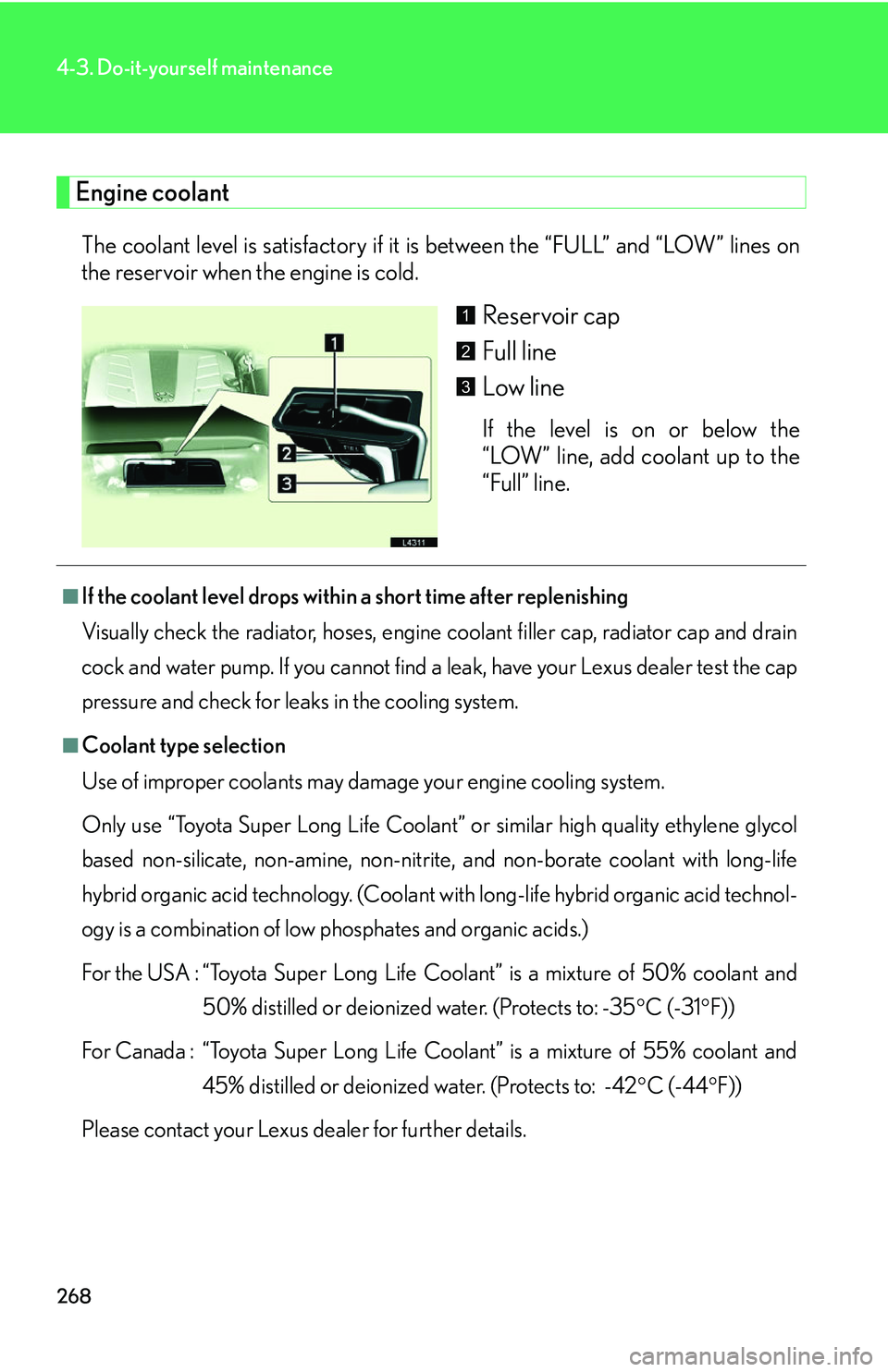
268
4-3. Do-it-yourself maintenance
Engine coolant
The coolant level is satisfactory if it is between the “FULL” and “LOW” lines on
the reservoir when the engine is cold.
Reservoir cap
Full line
Low line
If the level is on or below the
“LOW” line, add coolant up to the
“Full” line.
1
2
3
■If the coolant level drops within a short time after replenishing
Visually check the radiator, hoses, engine c
oolant filler cap, radiator cap and drain
cock and water pump. If you cannot find a leak, have your Lexus dealer test the cap
pressure and check for leaks in the cooling system.
■Coolant type selection
Use of improper coolants may dama ge y
our engine cooling system.
Only use “Toyota Super Long Life Coolant” or similar hig
h quality ethylene glycol
based non-silicate, non-amine, non-nitrite, and non-borate coolant with long-life
hybrid organic acid technology. (Coolant wi th long-life hybrid organic acid technol-
ogy is a combination of low phosphates and organic acids.)
For the USA : “Toyota Super Long Life Coolant” is a mixture of 50% coolant and 50% di
stilled or deionized water. (Protects to: -35 C (-31F))
For Canada : “Toyota Super Long Life Coolant” is a mixture of 55% coolant and 4
5% distilled or deionized water. (Protects to: -42 C (-44F))
Please contact your Lexus dealer for further details.
Page 285 of 419
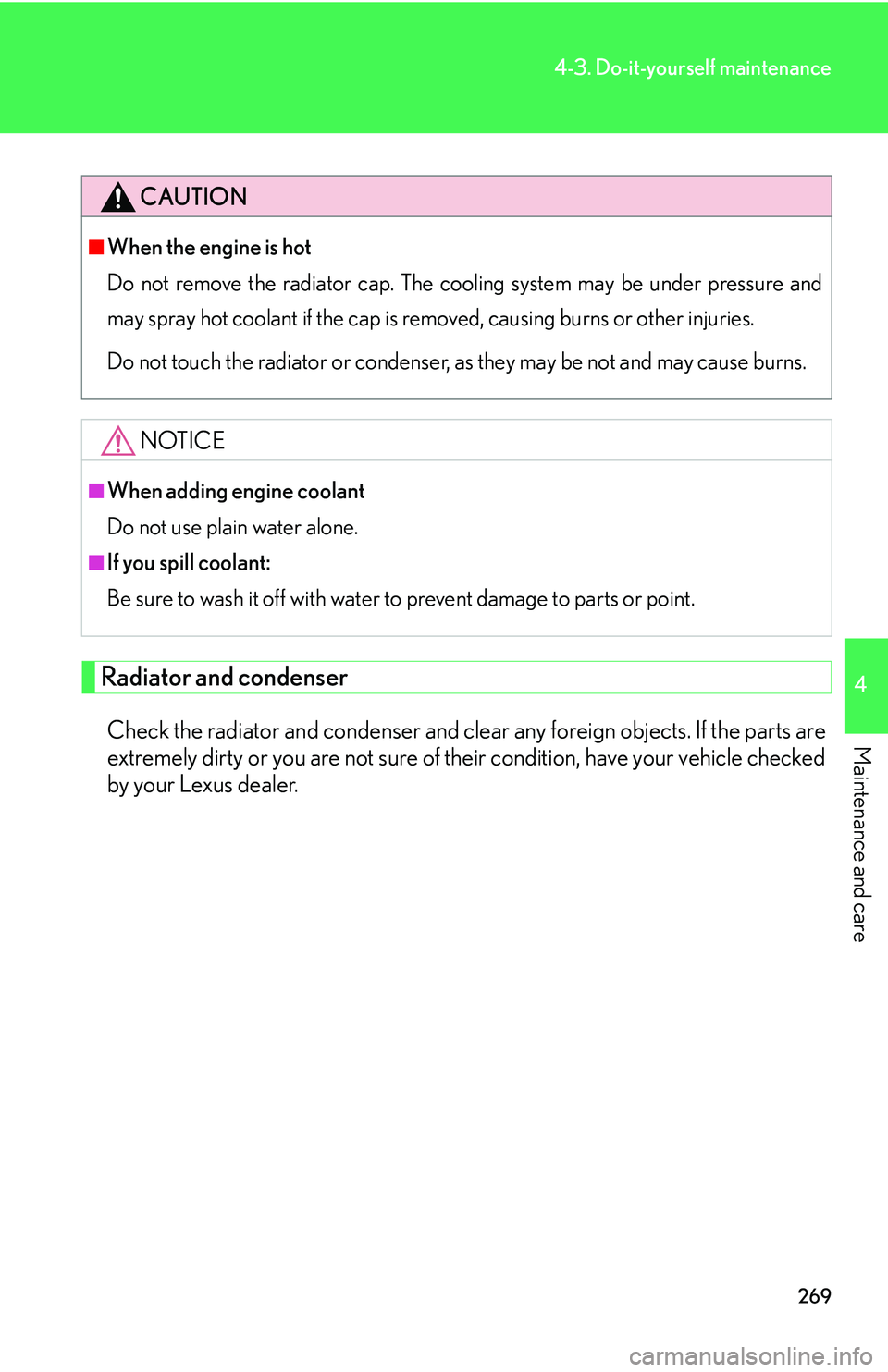
269
4-3. Do-it-yourself maintenance
4
Maintenance and care
Radiator and condenser
Check the radiator and condenser and clear any foreign objects. If the parts are
extremely dirty or you are not sure of their condition, have your vehicle checked
by your Lexus dealer.
CAUTION
■When the engine is hot
Do not remove the radiator cap. The cooling system may be under pressure and
ma
y spray hot coolant if the cap is removed, causing burns or other injuries.
Do not touch the radiator or condenser, as they may be not and may cause burns.
NOTICE
■When adding engine coolant
Do not use plain water alone.
■If you spill coolant:
Be sure to wash it off with water to prevent damage to parts or point.
Page 288 of 419
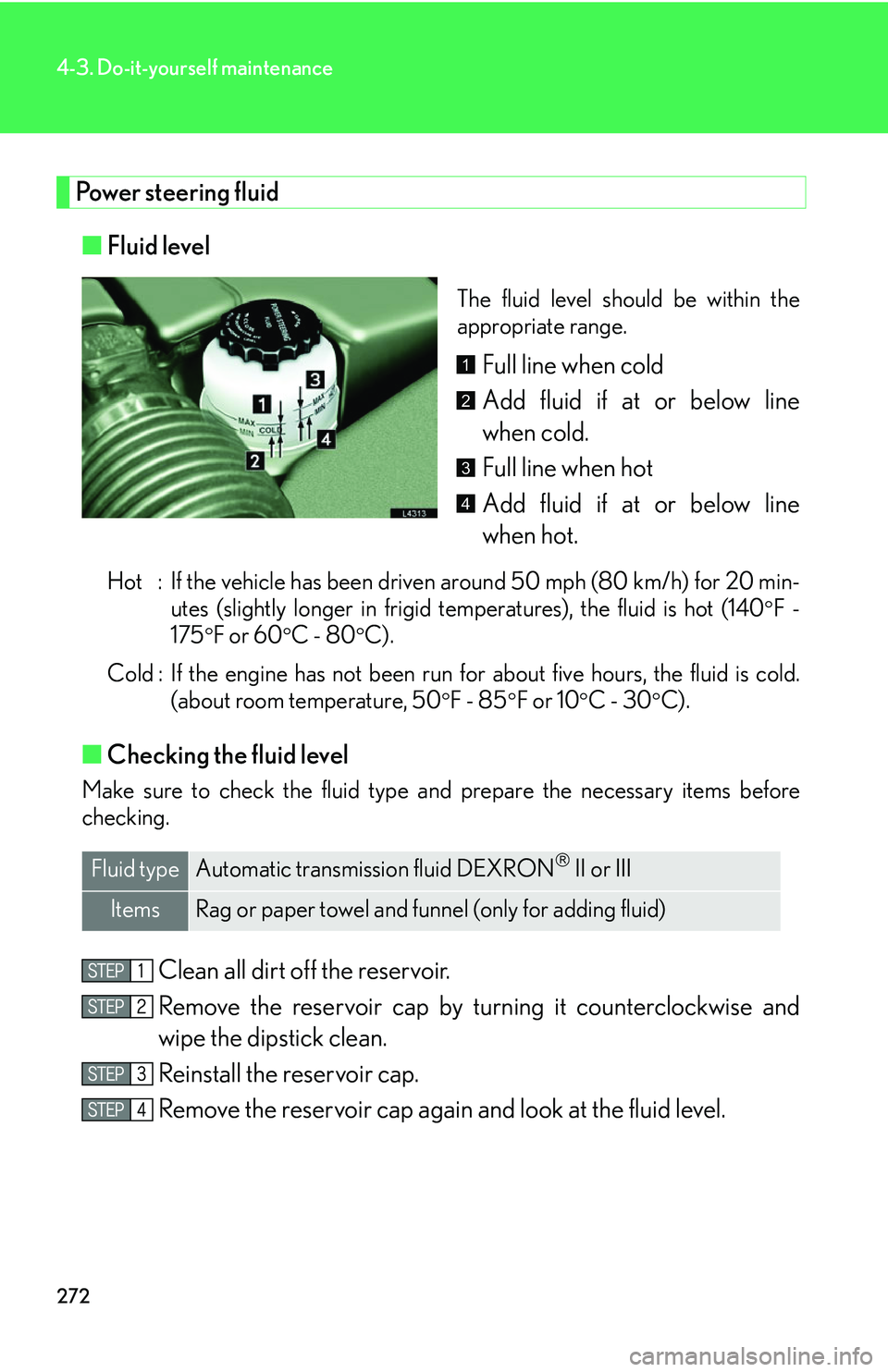
272
4-3. Do-it-yourself maintenance
Power steering fluid
■Fluid level
The fluid level should be within the
appropriate range.
Full line when cold
Add fluid if at or below line
when cold.
Full line when hot
Add fluid if at or below line
when hot.
Hot : If the vehicle has been driven around 50 mph (80 km/h) for 20 min -
utes (slightly longer in frigid te mper
atures), the fluid is hot (140F -
175
F or 60C - 80C).
Cold : If the engine has not been run for about
five hours, the fluid is cold.
(about room temperature, 50
F - 85F or 10C - 30C).
■ Checking the fluid level
Make sure to check the fluid type and prepare the necessary items before
checking.
Clean all dirt off the reservoir.
Remove the reservoir cap by tu rning it counter
clockwise and
wipe the dipstick clean.
Reinstall the reservoir cap.
Remove the reservoir cap again and look at the fluid le
vel.
1
2
3
4
Fluid typeAutomatic transmission fluid DEXRON II or III
ItemsRag or paper towel and funnel (only for adding fluid)
Page 314 of 419
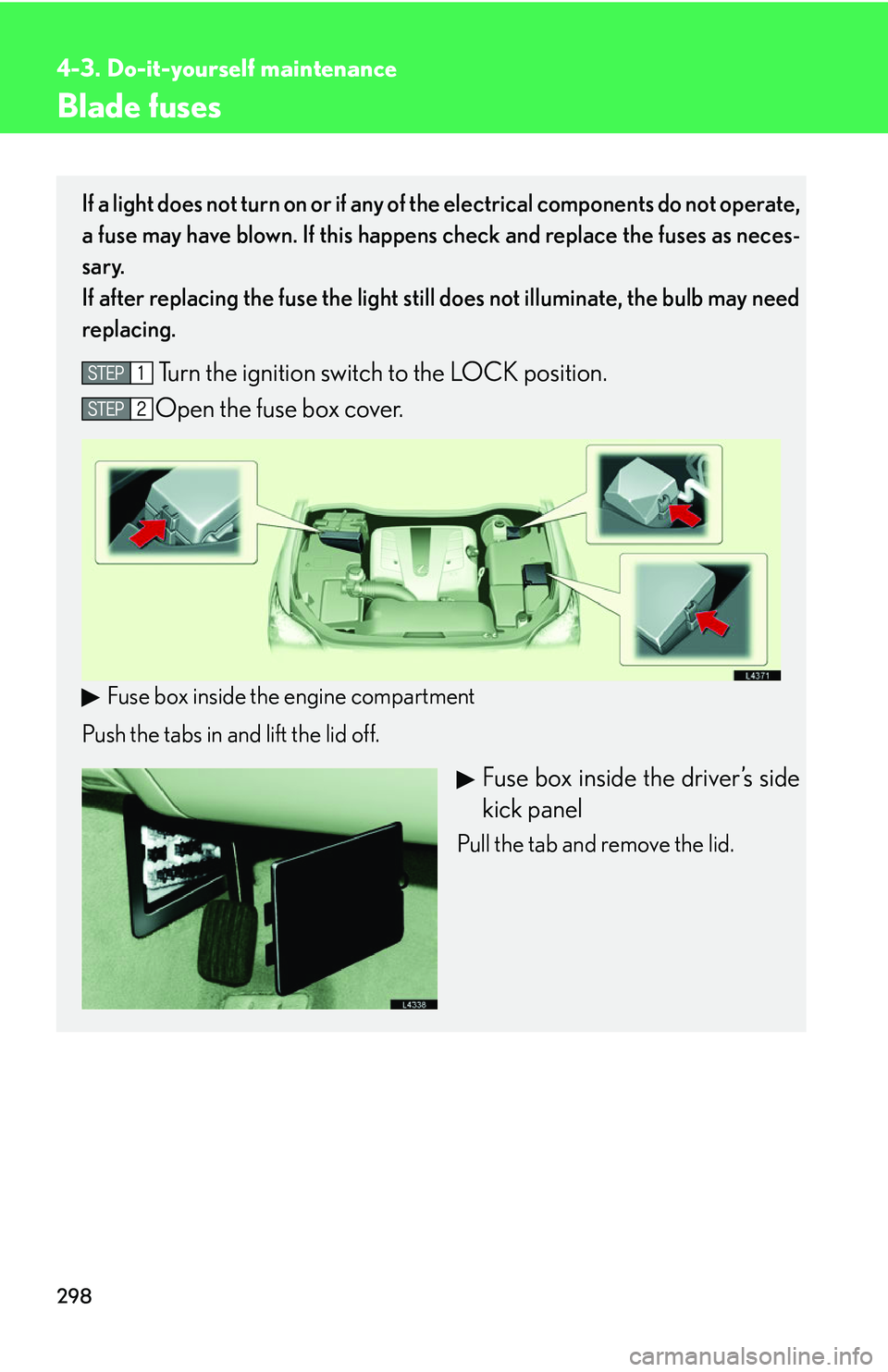
298
4-3. Do-it-yourself maintenance
Blade fuses
If a light does not turn on or if any of the electrical components do not operate,
a fuse may have blown. If this happens check and replace the fuses as neces
-
sary.
If after replacing the fuse the light stil l
does not illuminate, the bulb may need
replacing.
Turn the ignition switch to the LOCK position.
Open the fuse box cover.
Fuse box inside the engine compartment
Push the tabs in and lift the lid off.
Fuse box inside the driver’s side
kick panel
Pull the tab and remove the lid.
Page 325 of 419
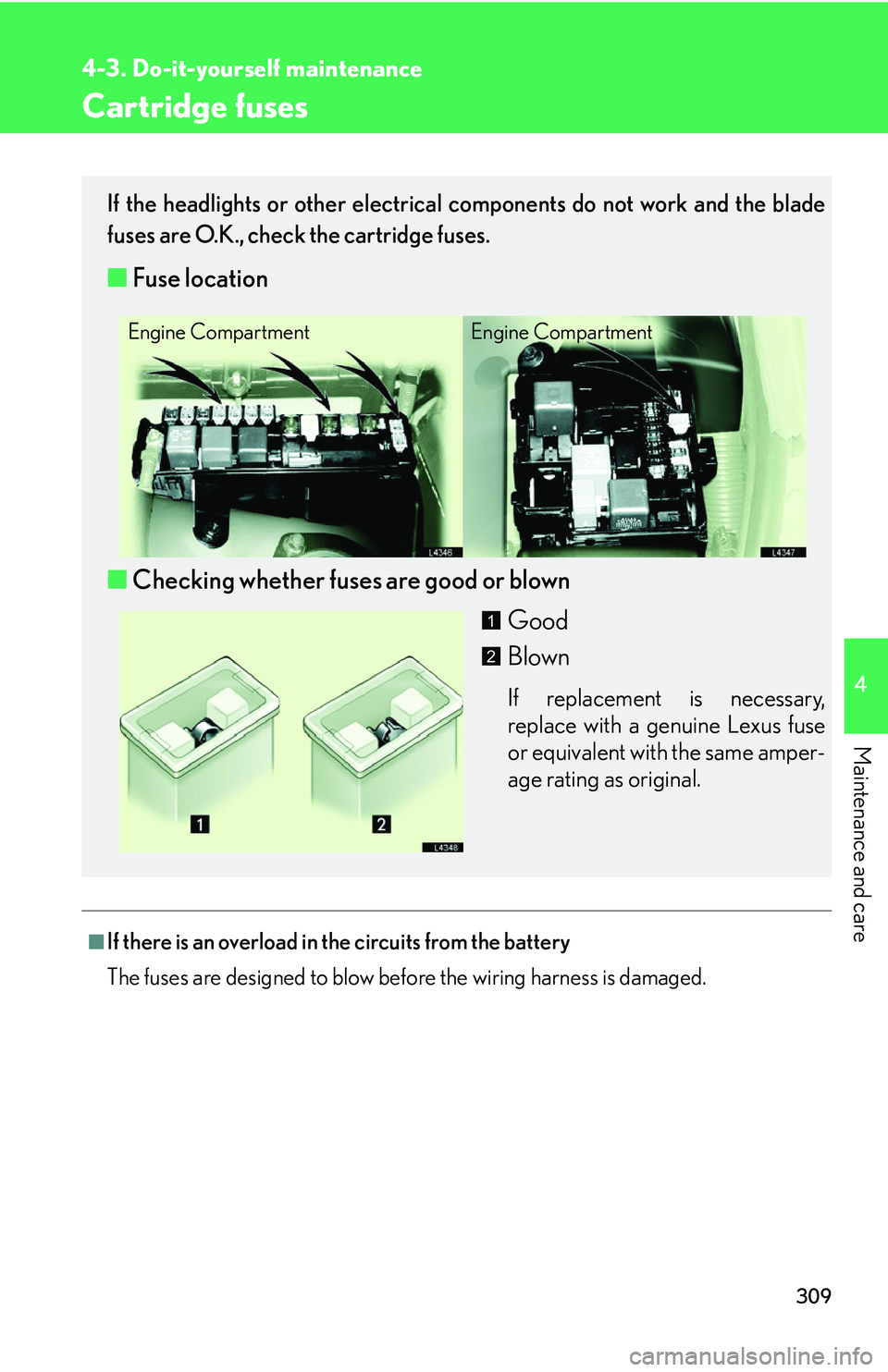
309
4-3. Do-it-yourself maintenance
4
Maintenance and care
Cartridge fuses
■If there is an overload in the circuits from the battery
The fuses are designed to blow before the wiring harness is damaged.
If the headlights or other electrical components do not work and the blade
fuses are O.K., check the cartridge fuses.
■ Fuse location
■ Checking whether fuses ar
e good or blown
Good
Blown
If replacement is necessary,
replace with a genuine Lexus fuse
or equivalent with the same amper -
age rating as original.
Engine CompartmentEngine Compartment
1
2
Page 340 of 419

324
5-1. Essential information
If you think something is wrong
If you notice any of the following symptoms, your vehicle probably needs
adjustment or repair. Contact your Lexus dealer as soon as possible.
■Visible symptoms
Look for any of the following symptoms.
• Fluid leaks under the vehicle
Water dripping from the air conditioning after use is normal
• Flat-looking tires or uneven tire wear
• Engine coolant temperature gauge needle continually points higher
than normal
■ A
udible symptoms
Listen for any of the following symptoms.
• Change in exhaust sound
• Excessive tire squeal when cornering
• Strange noises related to suspension system
• Pinging or other noises related to engine
■ P
roblems with operation
Check for any of the following symptoms.
• Engine missing, stumbling or running rough
• Appreciable loss of power
• Vehicle pulls to heavily one side when braking
• Vehicle pulls to heavily one sid e when driving on a le
vel road
• Loss of brake effectiveness, sp ongy feeling, pedal almost touches
floor
Page 349 of 419
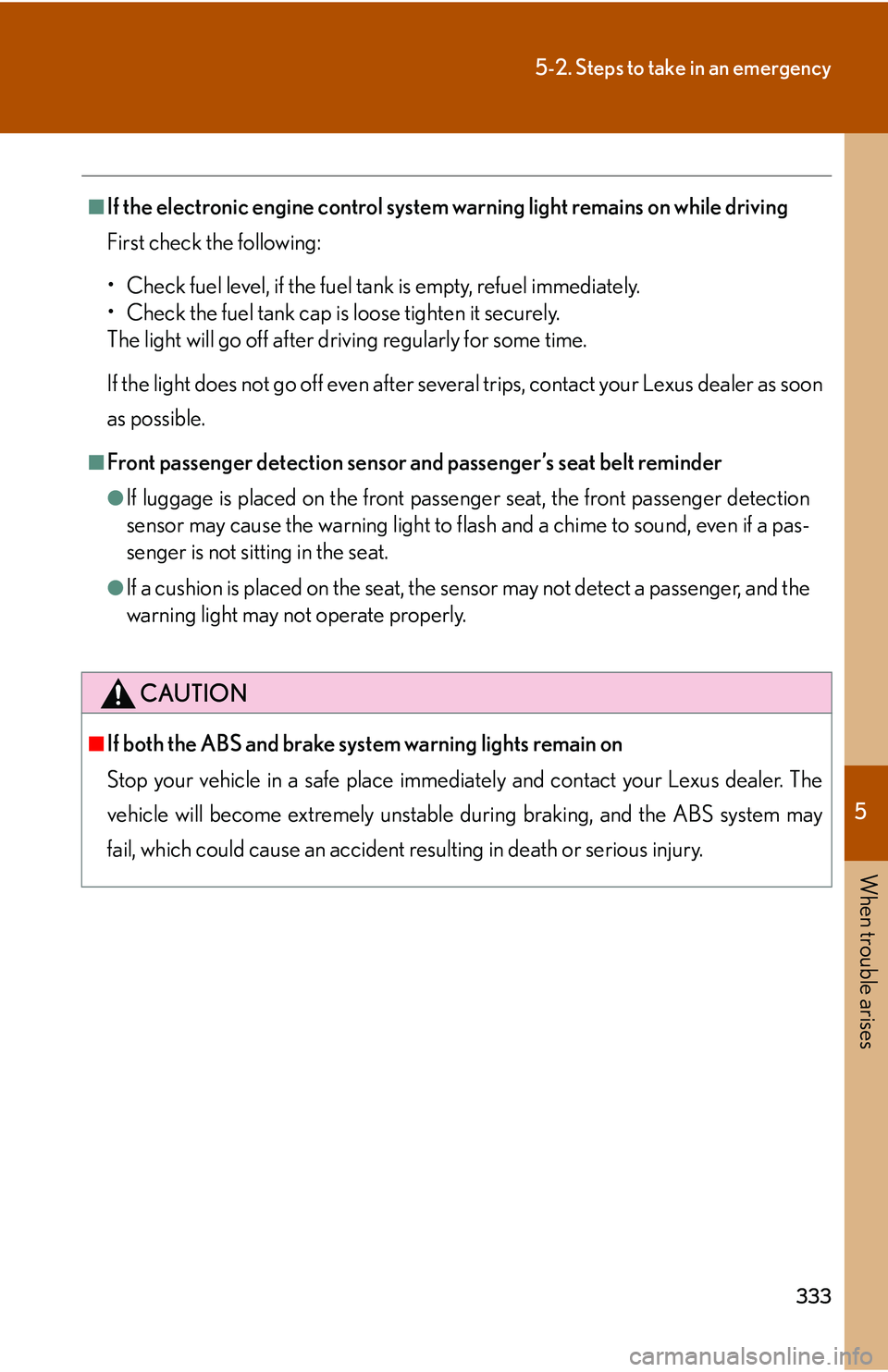
5
When trouble arises
333
5-2. Steps to take in an emergency
■If the electronic engine control system warning light remains on while driving
First check the following:
• Check fuel level, if the fuel tank is empty, refuel immediately.
• Check the fuel tank cap is loose tighten it securely.
The light will go off after driving regularly for some time.
If the light does not go off even after several trips, contact your Lexus dealer as soon
a
s possible.
■Front passenger detection sensor an d passenger’s seat belt reminder
●If luggage is placed on the front passenger seat, the front passenger detection
sensor may cause the warning light to flash and a chime to sound, even if a pas -
senger is not sitting in the seat.
●If a cushion is placed on the seat, the sensor may not detect a passenger, and the
warning light may not operate properly.
CAUTION
■If both the ABS and brake system warning lights remain on
Stop your vehicle in a safe place immediately and contact your Lexus dealer. The
v
ehicle will become extremely unstable during braking, and the ABS system may
fail, which could cause an accident resulting in death or serious injury.
Page 350 of 419
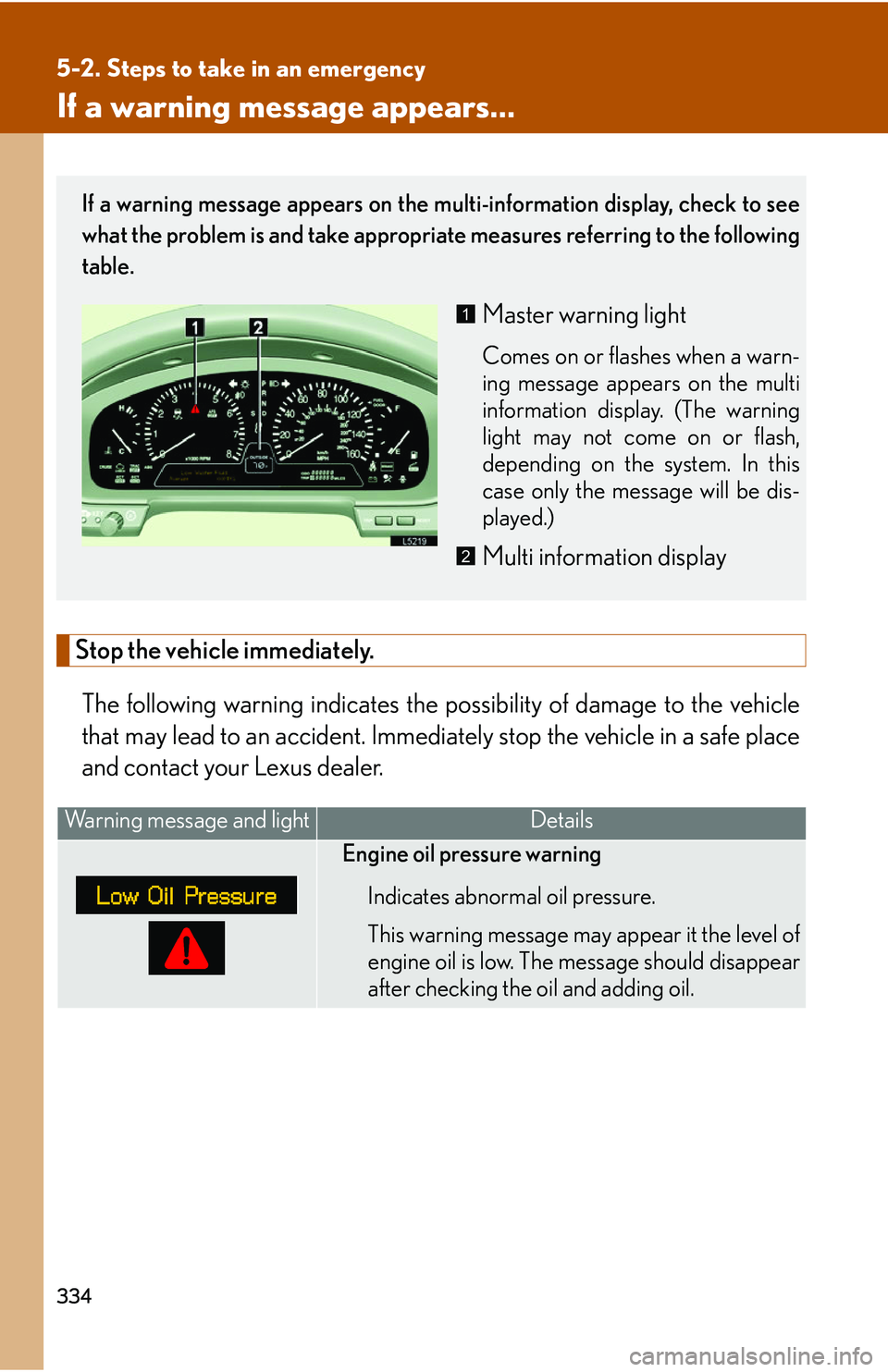
334
5-2. Steps to take in an emergency
If a warning message appears...
Stop the vehicle immediately.
The following warning indicates the possibility of damage to the vehicle
that may lead to an ac cident. Immediately stop the vehicle in a safe place
and contact your Lexus dealer.
Warning message and lightDetails
Engine oil pressure warning
Indicates abnormal oil pressure.
This warning message may appear it the level of
engine
oil is low. The message should disappear
after checking the oil and adding oil.
If a warning message appears on the multi-information display, check to see
what the problem is and take appropriat e measures referring to the following
table.
Master warning light
Comes on or flashes when a warn -
ing message appears on the multi
information display
. (The warning
light may not come on or flash,
depending on the system. In this
case only the message will be dis -
played.)
Multi information display
1
2
Page 353 of 419
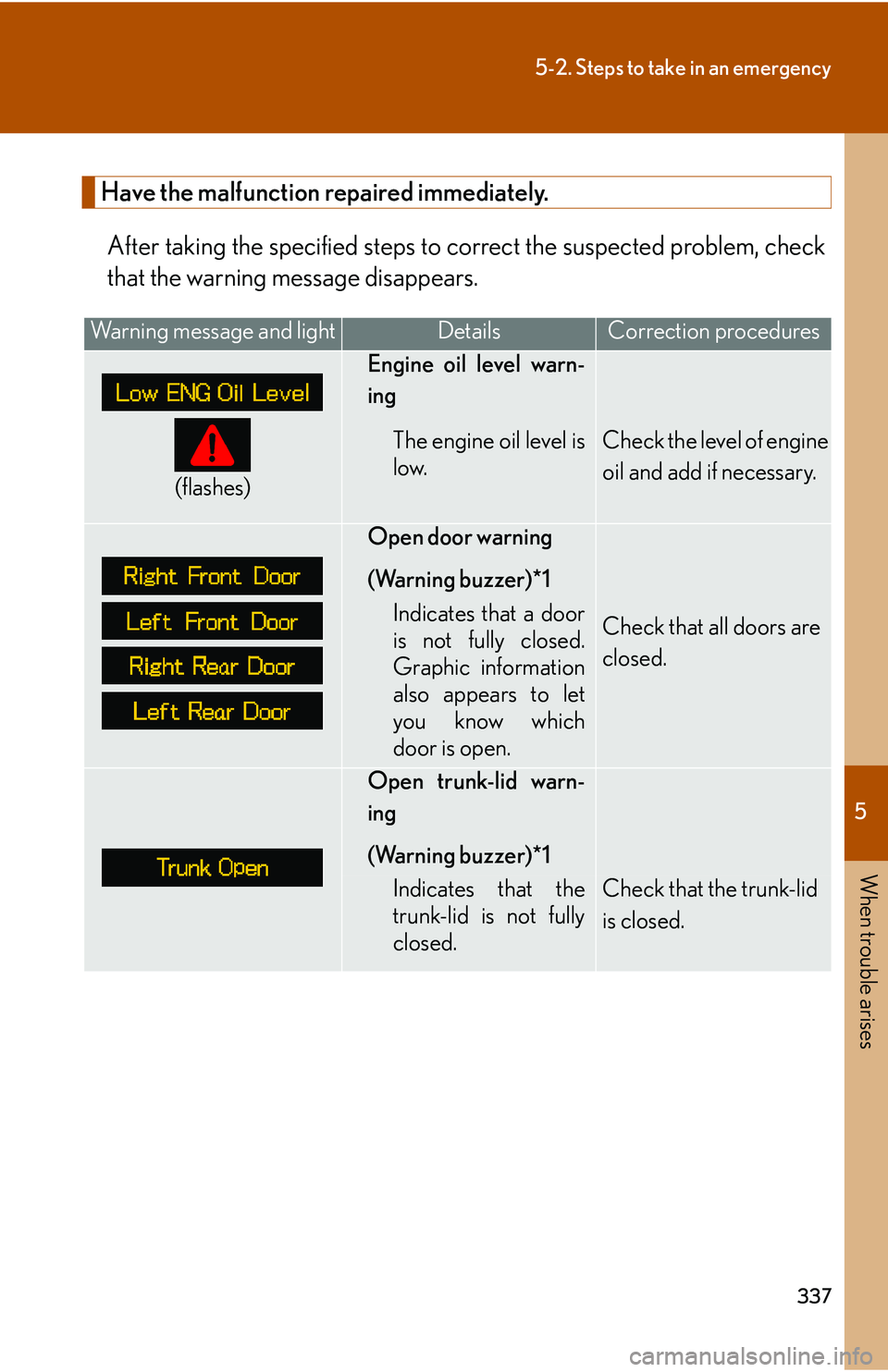
5
When trouble arises
337
5-2. Steps to take in an emergency
Have the malfunction repaired immediately.
After taking the specified steps to correct the suspected problem, check
that the warning message disappears.
Warning message and lightDetailsCorrection procedures
(flashes)
Engine oil level warn-
ing
The engine oil level is
low.Check the level of engine
oil and add if necessary.
Open door warning
(Warning buzzer)*1
Check that all doors are
closed.Indicates that a door
is not fully closed.
Graphic information
also appears to let
you know which
door is open.
Open trunk-lid warn-
ing
(Warning buzzer)*1
Indicates that the
trunk-lid is not fully
closed.Check that the trunk-lid
is closed.
Page 368 of 419
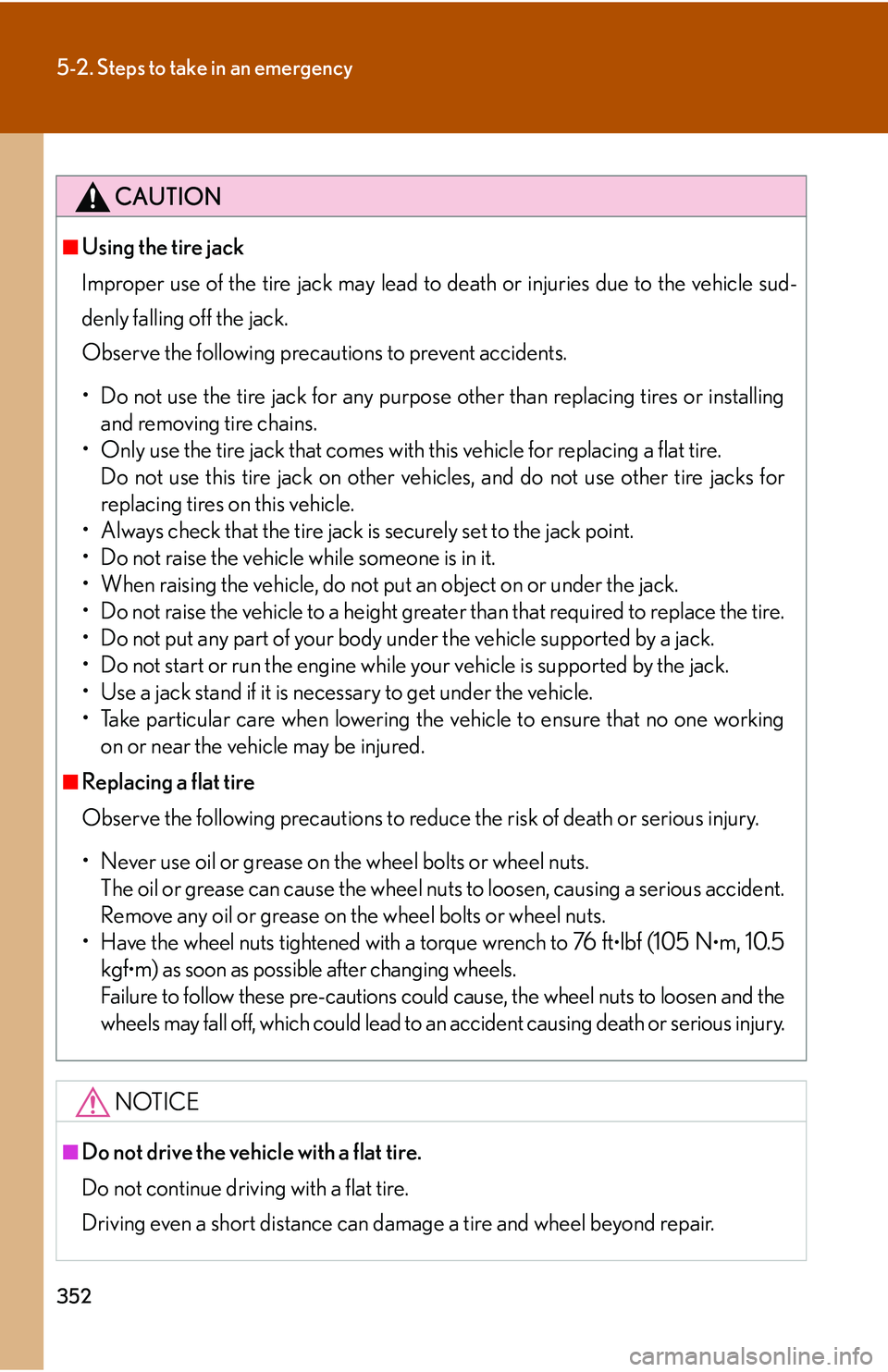
352
5-2. Steps to take in an emergency
CAUTION
■Using the tire jack
Improper use of the tire jack may lead to death or injuries due to the vehicle sud-
denly falling off the jack.
Observe the following precautions to prevent accidents.
• Do not use the tire jack for any purpose other than replacing tires or installing and
removing tire chains.
• Only use the tire jack that comes with this vehicle for replacing a flat tire.
Do not use this tire jack on other vehicl
es, and do not use other tire jacks for
replacing tires on this vehicle.
• Always check that the tire jack is securely set to the jack point.
• Do not raise the vehicle while someone is in it.
• When raising the vehicle, do not put an object on or under the jack.
• Do not raise the vehicle to a height greate r than
that required to replace the tire.
• Do not put any part of your body under the vehicle supported by a jack.
• Do not start or run the engine while your vehicle is supported by the jack.
• Use a jack stand if it is necessary to get under the vehicle.
• Take particular care when lowering the vehicle to ensure that no one working on or
near the vehicle may be injured.
■Replacing a flat tire
Observe the following precautions to reduce
the risk of death or serious injury.
• Never use oil or grease on the wheel bolts or wheel nuts.
The oil or grease can cause the wheel nuts to loosen, causing a serious accident.
R
emove any oil or grease on the wheel bolts or wheel nuts.
• Have the wheel nuts tightene d with a tor
que wrench to 76 f t•lbf (105 N•m, 10.5
kgf
•m) as soon as possible after changing wheels.
Failure to follow these pre-cautions could cause, the wheel nuts to loosen and the
w
heels may fall off, which could lead to an accident causing death or serious injury.
NOTICE
■Do not drive the vehicle with a flat tire.
Do not continue driving with a flat tire.
Driving even a short distance can damage a tire and wheel beyond repair.